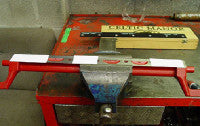Packing Bottom Blades
Packing Bottom Blades
By Pat Callaby, Head Mechanic, Celtic Manor GC
The biggest waste of bedknives (bottom blades) is grinding them flat unnecessarily when the problem is that the bedknife carrier (bed bar) itself is not flat. This can be put right by grinding the bed bar on the bottom blade grinder using adaptors supplied by the grinder manufacturers.
This can take some time because the surface area to be ground is much larger than the ground area of a bedknife and consequently the amount of metal that can be removed in a single pass is very small if the electric motor driving the grinding stone is not to be overloaded. This is the long term/permanent solution to the problem of wasted bedknives, but a short-term answer is to pack the bedknives with paper to get a level fit.
Fit the new bedknife to a clean bed bar (the bed bar should be free of rust scale, paint and any other contaminants that could distort the bedknife).

A clean bedbar
Smear the bed bar surface with copper grease or similar to prevent rust forming and fit the bedknife as normal, adjust the "set" and test the cut.

Bedknife marked clearly
Mark the bedknife with chalk where the cut is poor or non-existent, (this is where the bedknife is to far away from the reel to give a good cut) remove the bedknife and place paper on the areas where the cut was good to lift the bedknife away from the bed bar, this will increase the gap between the bedknife and the reel hopefully to match gap in the areas of the poor cut. Ensure the bed bar is fully covered from the leading edge to the back edge: ~

Paper in correct position
Re-fit the bedknife, adjust the set and test the cut, again mark the bedknife in the poor cut areas, remove the bedknife and add more paper in the good cut areas. As you become more experienced you will be able to make a good guess at how many layers of paper are needed and minimize the number of times the blade needs to be removed.
You can also tip the blade by placing paper behind the bedknife screws between the screw holes and the heel of the bed bar, this will lift the rear of the blade and push the cutting edge towards the reel.
A combination of both methods works very well and time spent doing it will mean less time grinding and a longer life from the blade.

